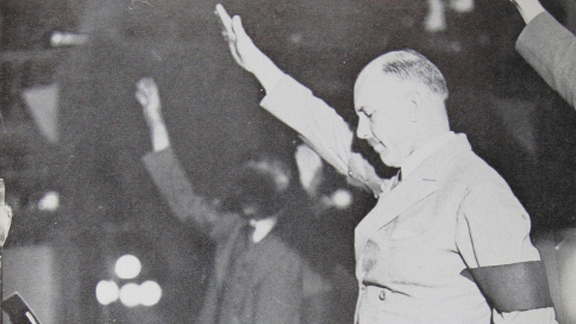The secret history of fascism in Australia

There is a myth that Australia, with its supposed democratic, egalitarian traditions, has been immune from mass fascist movements. This is far from true.
Fascism as a mass phenomenon is a product of a capitalist system that is in deep social and political crisis. That was the case with the onset of the Great Depression in the 1930s.
In 1931-32 there were 130,000 Australians under arms, out of a population of just over 6 million. They trained and drilled with an assortment of fascist or far right paramilitary organisations. These were so-called respectable citizens: solicitors, doctors, dentists, graziers and business owners.
Support for Hitler and Mussolini was widespread in establishment circles.
In 1933, the Melbourne Herald ran a series of articles titled “Why I have become a fascist” by Wilfrid Kent Hughes, a Victorian MP. Kent Hughes came from a well connected Melbourne family. He had been school captain at Melbourne Grammar and a Rhodes Scholar at Oxford. He went on to become deputy premier of Victoria. In the 1950s he was a minister in Menzies’ federal Liberal government.
Menzies, Australia’s longest serving prime minister, was glowing in his praise of Nazi Germany. In 1938, when federal attorney general, he visited the country and enthused about the “really spiritual quality in the willingness of Germans to devote themselves to the service and well being of the state”.
Hitler and Mussolini were viewed as heroes by conservatives because they had crushed the socialist movement and smashed the unions. They had ensured that profits kept rolling in. An editorial in the Sydney Morning Herald declared: “Italy was only saved from Red dominance by the heroic remedy of fascism”.
Another typical example comes from 1937. William Mackay, the NSW police commissioner, established the first Police Boys Clubs. They were modelled on the Nazi labour youth battalions, which he admired because they “subordinate the individual to the welfare of the nation”.
Mackay’s fellow police commissioner in Victoria, Thomas Blamey, headed the main far right paramilitary organisation the League of National Security (also known as the White Army). Blamey went on to become a field marshal and commander of the army in World War Two.
1930s crisis
The crisis of the Depression years led to a political and social polarisation along class lines. More than 30 percent unemployment, wage cuts, widespread evictions and mass poverty led masses of workers to question the whole basis of capitalist society.
In NSW, the radical populist Labor premier Jack Lang won an enormous following. To the left of Lang, the Socialisation Units – which were committed to the immediate introduction of socialism – enrolled tens of thousands. The Communist Party also grew.
Ruling class opinion was hysterical about Lang. Lang was no revolutionary, but he was seen as opening the way for all the disloyal elements in society – the Reds, the unemployed and the Irish Catholics. Irish Catholics were the Muslims of the day – they had betrayed the empire during its hour of need during World War One by revolting against Protestant rule.
The New Guard is the best known of the far right groups. It was formed in February 1931 as a breakaway from the much larger and more powerful Old Guard, which had prominent capitalist backers and operated secretly.
The New Guard, with 36,000 members, was an open fascist organisation that physically attacked union, ALP, unemployed and communist meetings. Its leader, Eric Campbell, visited Italy and Germany and established close relations with the fascists there. It was more middle class in character than the Old Guard. Former prime minister John Howard’s father, Lyall, a petrol station owner, was typical.
Every state had its own fascist or far right organisations. In March 1931, the League of National Security staged a trial run at a coup. Its armed militias seized dozens of towns across rural Victoria.
But the height of far right mobilisation was in NSW. The Melbourne Herald declared: “Today in NSW the deliberate process of smashing is going on under our noses. Sovietism and revolution have found their instrument in Lang”.
In April 1932, the New Guard organised a riot outside Sydney’s Central Police Station as a trial run for a coup. It went badly. But just over a month later, on 13 May, Lang was gone.
The Old guard – which had close connections with the police, the armed forces and the security apparatus, and whose leadership read like a who’s who of the Sydney establishment – mobilised to bring his government down. As well as a secret military wing, it had an open front organisation of 130,000 members called the All Australia League.
Under tremendous pressure from the ruling class, state governor Philip Game sacked Lang in a soft coup. An armed fascist revolt was no longer necessary. Soon afterwards, Scullin’s federal Labor government also fell.
Legacy
Capitalist rule had been stabilised without the need for a full blown fascist regime. But the far right and fascist mobilisations had a profound impact on Australian politics, which was pushed well to the right.
The conservative governments that came to power federally and in NSW shared many of the values of the New and Old Guard. Indeed, at least 20 NSW members of parliament were members of the New Guard. There were others from the Old Guard.
The parliamentary arm of the right achieved a lot of what the paramilitary wing desired: democratic rights sharply undermined, major attacks on free speech, a harsh censorship regime, and a crackdown on the left, the unions and the unemployed.
All this ensured that the burden of the Depression was imposed on the working class and that the profits of the banks and big capital were secured.
For large numbers of workers, Depression-level wages and conditions were maintained for many years after the economy began to pick up.
The fascists and their backers had achieved their main goal.